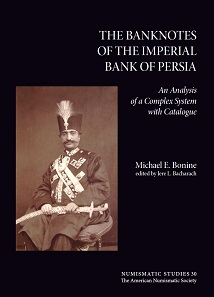by Ursula Kampmann
translated by Christina Schlögl
April 27, 2017 – On 30 January 1889, financier and businessman Baron George de Reuter, son of the founder of the famous news agency, founded the Imperial Bank of Persia. It constituted a sort of compromise, by which the Iranian Shah wanted to appease the British without angering the Russians. No one had been able to come to a settlement regarding the planned construction of a railway. Instead, it was the bank that should now raise the money to build a railway without any diplomatic resentments. George de Reuter had the Bank of England officially approve the founding of his “Imperial Bank of Persia”. They determined that the bank had to have its main office in London, while it could only open branches in Iran. This was a complicated legal situation, which is accounted for by the banknotes of the institute with their additional marking. Michael E. Bonine has occupied himself with this subject matter for years. He created a comprehensive study which was published after his death by Jere L. Bacharach as a monograph in the series Numismatic Studies of the American Numismatic Society.
Michael E. Bonine (published posthumously by Jere L. Bacharach), The Banknotes of the Imperial Bank of Persia. An Analysis of a Complex System with Catalogue. Numismatic Studies 30. The American Numismatic Society, New York 2016. 148 p., all illustrations in colour, 28.5 x 22.3 cm, Hardcover. ISBN: 978-0-89722-337-9. GBP 65 or US$ 100.
This is not only an asset for numismatics, but particularly so for the economic history of Persia. It is due to Bacharach’s initiative that this thoroughly worked out catalogue with its elaborate historic-numismatic commentary did not get lost. Bonine masterfully shows how the analysis of the material in combination with the use of archival sources allows for a detailed classification of a rather complicated subject matter. After all, the banknotes of the “Imperial Bank of Persia” do not only have different serial numbers. They were also marked with different stamps which represent the different Persian bank branches. The banknotes could only be redeemed at the issuing bank. Between December of 1889 and the withdrawal of the right to give out banknotes in 1932, the Imperial Bank of Persia opened an impressive 28 branches, only two of which did not issue banknotes. Consequently the banknotes that were printed in Great Britain and exported to Persia only became valid once they got their respective stamp mark in the bank branch.
This richly illustrated study on these banknotes also features a catalogue with pictures of all denominations, so that even a coin dealer who has to draft his or her catalogue under time pressure, will be able to determine the rare and expensive banknotes in no time. However, one still has to stay cautious, because Michael Bonine, an enthusiastic collector himself, hints at one peculiarity in the Persian way of handling these banknotes. They have often been folded many times into smaller pieces in order to store them. As a consequence, most of the banknotes’ grade is heavily compromised. Recently though, people in Iran have specialised in smoothening, washing and ironing the banknotes, and one has to pay close attention to the notes to be able to tell their actual grade.
Should anyone offer you a bank note without a stamp mark, this does not mean that it is fake. It could well come from a robbery that occurred in 1907 during a transport of the banknote blanks.
Michael Bonine has worked with an interesting subject matter and he tells us fascinating stories. The editor of the book explains this with the scholar’s curiosity. He who has passed much too soon. It was already during the 1960s that he took his Landrover (and his wife Marilyn) and went from London to Iran. Never let it be said that numismatics is a couch potato discipline! The author’s advice from his book’s inscription, dedicated to his grandchildren, goes for numismatists, too: Go, explore the world!
Europeans can order the book via Oxbow.
For our readers in the US it should be easier to use the website of the ANS.





